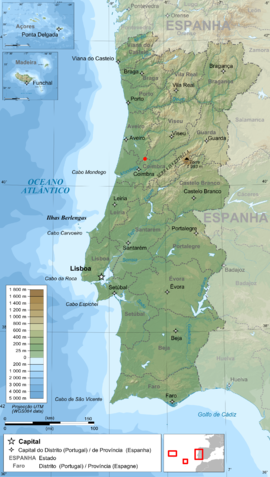Buçaco Forest
| Buçaco Forest (Mata Nacional do Buçaco) | |
| part of the Serra do Buçaco | |
|
The Fonte Fria (Cold Fountain) in Buçaco Forest is a cascading water stairway built in the 1880s.
|
|
| Country | Portugal |
|---|---|
| Region | Centro |
| District | Aveiro |
| Municipality | Mealhada |
| Nearest parish | Luso |
| Elevation | 547 m (1,795 ft) |
| Coordinates | 40°22′37″N 8°21′55″W / 40.377077°N 8.36533°WCoordinates: 40°22′37″N 8°21′55″W / 40.377077°N 8.36533°W |
| Management | Fundação Mata do Buçaco |
| Website | http://www.fmb.pt |
Buçaco Forest (Portuguese: Mata Nacional do Buçaco) is an ancient, walled arboretum in the Centro region of Portugal and home to one of the finest dendrological collections in Europe. The forest measures 1450 meters by 950 meters and covers an area of 105 hectares; the perimeter wall is approximately 5 kilometres (3.1 mi) in circumference and punctuated by a series of gates, one of which bears the text of 17th-century papal bulls forbidding women to enter and threatening to excommunicate anyone harming the trees. More than 250 tree and shrub species grow in the forest, including huge centenarians and exotics introduced by Portuguese mariners during the Age of Discovery. In 2004 Portugal submitted Buçaco Forest to UNESCO's tentative list of World Heritage Sites.
Many of the forest's trees have been discussed in popular and academic literature. In 1634, for example, a Portuguese scholar authored a collection of poems that mentioned Buçaco's cypresses; in 1768 an English botanist provoked a 200-year-long debate by claiming one of the forest's cypress varieties originated in Goa; in the late 1990s wine writer Hugh Johnson visited the arboretum and described a Tasmanian mountain ash as "surely Europe's most magnificent"; more recently, historian and arborist Thomas Pakenham included one of the forest's bunya pines in his book, Remarkable Trees of the World.
Buçaco Forest was once home to Discalced Carmelites: the monks built a convent, small chapels and the encircling walls, and tended the arboretum until the dissolution of the monasteries in 1834. At the end of the 19th century much of the convent was demolished to make way for an extravagant neo-Manueline palace. The palace was conceived as a retreat for the Portuguese royal family, but after the Lisbon Regicide and subsequent coup d'état it was converted to a luxury hotel, the Buçaco Palace.
...
Wikipedia


